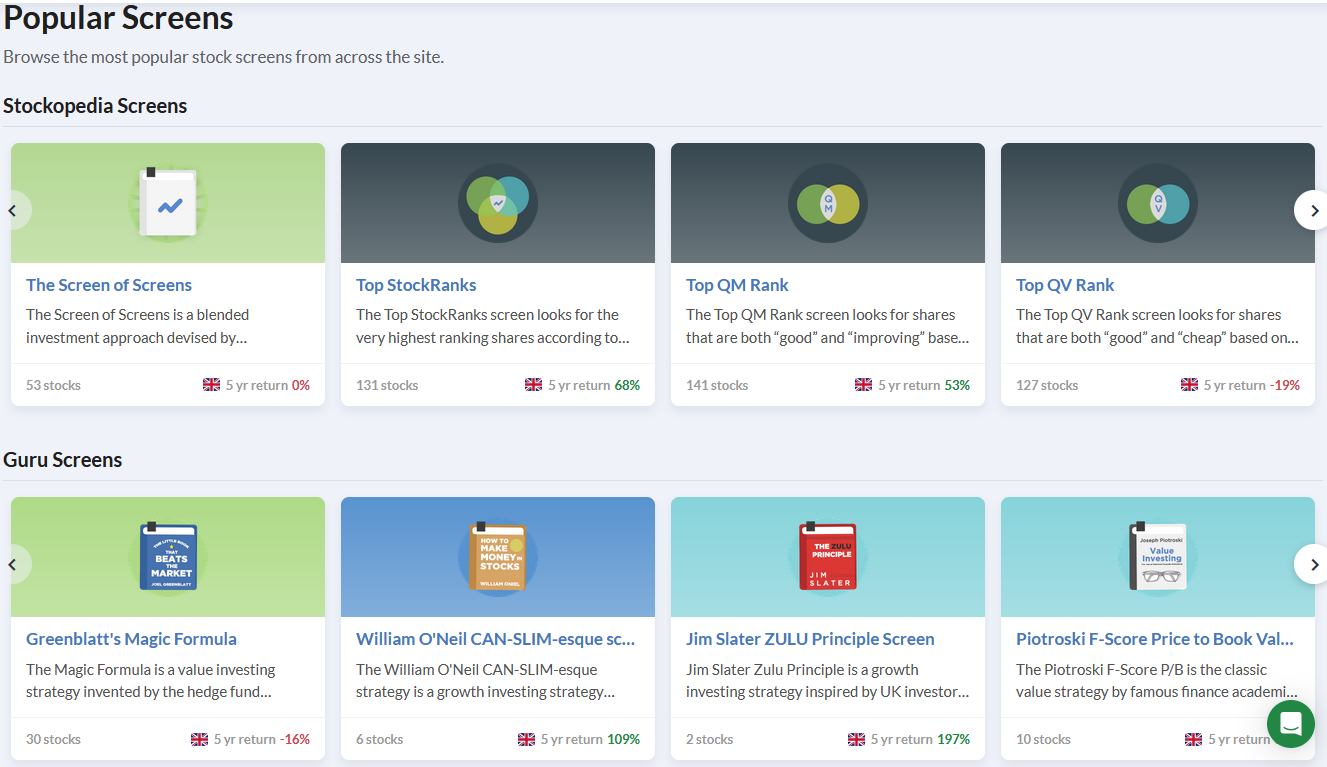Why even the best stockpickers use screens
Screening tools are a core part of our offer at Stockopedia, together with the StockRanks.
As data-driven, systematic investors, we believe that it makes sense to use financial rules to narrow down our investment universe to a smaller, more manageable list of ideas for further research.
Screening for stocks can be as simple as looking for dividend shares with a yield over 4%. It might just mean finding growth stocks whose sales have risen by at least 15% a year for the last three years.
Screens can be much more sophisticated than this, too, but the core concept never changes. A good screen will strip out all the companies that don’t meet your criteria and leave you with a shorter and more focused list of higher probability shares to investigate further.
Not only does screening help to exclude companies you don’t want to own – it may also highlight opportunities you would not otherwise have identified.
Expert investors rely on screens
Screening shouldn’t just be seen as an aid for inexperienced investors. More than 75 years ago, value investing pioneer Ben Graham built a successful investment business based on his insight that buying cheap stocks delivered above-average results.
In his classic book The Intelligent Investor, Graham set out clear rules that could be used to identify businesses with the qualities and valuations he looked for. Graham didn’t have access to computer power or digital data, but his strategy was an early example of a formalised screening approach.
Ben Graham became Warren Buffett’s mentor, and Buffett extended and evolved the data-driven value investing approach he learned from Graham.
Many notable investors have followed Graham’s example since then. In his Fundsmith Owners Manual, founder Terry Smith discusses how his team uses screening tools to find (and eliminate) potential investments:
… We intend to find companies which are potential investments by a screening process of their financial results to identify high return, cash generative, consistently performing businesses.
Many other noted investors and fund managers have also developed repeatable processes for finding potential investments. We’ve converted many of these into preset Guru Screens, giving subscribers access to investment ideas across a broad spectrum of investing styles.
We also offer StockRanks-based screens, which allow investors to screen for stocks with different combinations of Quality, Value and Momentum Ranks. These factors have been shown to improve the probability of a positive result, as we’ve discussed elsewhere in the Academy.
Can we really fix the odds by screening?
You might argue that relying on the results achieved by famous investors and academic research papers leaves us open to accusations of data mining and survivorship bias.
For example, what about all the fund managers who followed factor-based quality strategies but failed to outperform? It’s a reasonable question.
Another potential concern might be that while value and quality styles are well suited to screening, this is less true of growth stocks. With faster-growing, less mature businesses, there’s a possibility that understanding the investment story and backing management could potentially play a more significant role in shareholder returns.
Our Fix the Odds research study was designed to answer questions such as these by factoring in the random element of portfolio construction across a broad range of investing styles.
The study was driven by the knowledge that even if multiple investors used the same set of screening rules to help them build a portfolio, they’d all end up with slightly different portfolios. Using their judgement and research, each investor would select a different mix of stocks from the short list created by the screening results.
We wanted to know if the benefits of screening for proven financial factors were reliable enough to offset this random element.
Can we really use screens to fix the odds in our favour?
For this study, we used computer simulations to build 60,000 portfolios using six different screening strategies:
Each screening strategy included a set of financial criteria that was applied to the UK market. We then built 10,000 simulated portfolios for each strategy, with stocks randomly selected from each screen’s results.
These portfolios were liquidated and recreated annually from 2015 to 2023, giving a nine-year duration.
You can read the full report here, including details of the screening criteria we used for each type of portfolio.
In short, we found that screening solely for quality growth performed best. This strategy generated a median return from 10,000 portfolios of 52%, beating the market by an average of 32%.
Screening for quality factors alone also performed well, with a median return of just over 40% -- around 20% ahead of the market average.
Portfolios with value-related themes scored somewhere in the middle, with a median return of 19% in nine years, which was broadly level with the wider market.
At the bottom of the results table, pure growth was by far the worst performer. Portfolios of stocks randomly selected from the results of our growth screen delivered a median loss of 2.6% over nine years, lagging the wider market by more than 20%, on average.
It’s worth emphasising that these past results are not a guide to future performance. The nine years of the study included Brexit, the Covid-19 pandemic and a period of zero interest rates. The next nine years will be different.
Despite this, we would argue that our Fix the Odds research highlighted the trends we expected. Stocks selected from screen results can outperform, especially in the quality and value arenas.
Even so, we continue to believe the best results are likely to come when investors use screen results as a starting point for their own in-depth research. Our study results suggested that this is especially true for growth stocks.
Getting started with screening
Building your own screen enables you to create a set of results that should match your personal investing style.
In contrast, using our GuruScreens and StockRank screens allows you to stand on the shoulders of giants, benefiting from decades of hard-won experience and academic research.
Whichever route you choose, we believe that when used correctly, screening is a powerful tool with the potential to enhance investors’ returns.
To learn more about screening and related topics, click here.

